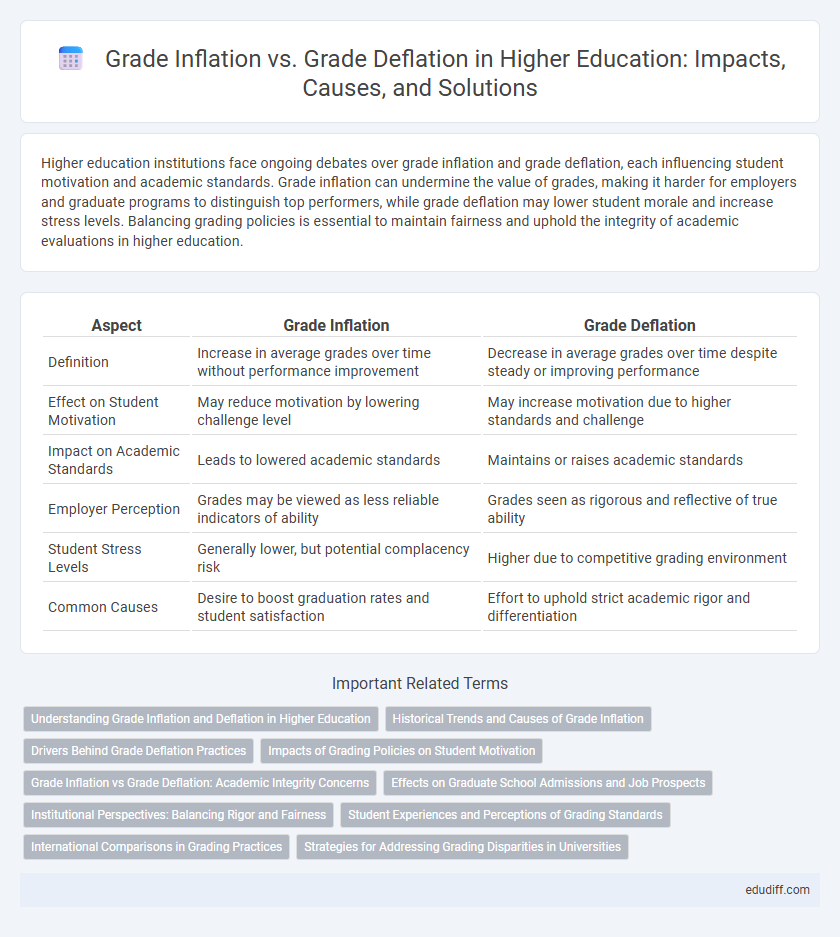Higher education institutions face ongoing debates over grade inflation and grade deflation, each influencing student motivation and academic standards. Grade inflation can undermine the value of grades, making it harder for employers and graduate programs to distinguish top performers, while grade deflation may lower student morale and increase stress levels. Balancing grading policies is essential to maintain fairness and uphold the integrity of academic evaluations in higher education.
Table of Comparison
| Aspect | Grade Inflation | Grade Deflation |
|---|---|---|
| Definition | Increase in average grades over time without performance improvement | Decrease in average grades over time despite steady or improving performance |
| Effect on Student Motivation | May reduce motivation by lowering challenge level | May increase motivation due to higher standards and challenge |
| Impact on Academic Standards | Leads to lowered academic standards | Maintains or raises academic standards |
| Employer Perception | Grades may be viewed as less reliable indicators of ability | Grades seen as rigorous and reflective of true ability |
| Student Stress Levels | Generally lower, but potential complacency risk | Higher due to competitive grading environment |
| Common Causes | Desire to boost graduation rates and student satisfaction | Effort to uphold strict academic rigor and differentiation |
Understanding Grade Inflation and Deflation in Higher Education
Grade inflation in higher education occurs when average grades progressively increase without a corresponding rise in student performance, leading to diminished academic standards and reduced credential value. Conversely, grade deflation reflects stricter grading policies that lower average grades, potentially harming student morale and competitiveness in job markets. Understanding the balance between these trends is crucial for institutions aiming to maintain academic integrity while supporting student success.
Historical Trends and Causes of Grade Inflation
Historical trends in grade inflation reveal a consistent upward shift in average grades across higher education institutions, with causes rooted in increased student competition, administrative pressures to improve retention rates, and evolving pedagogical standards. Research indicates that universities have experienced a rise in A grades distribution by over 15% since the 1960s, driven by faculty incentives and changing societal expectations regarding academic success. These factors collectively contribute to the dilution of grade distinctions, complicating objective assessments of student performance over time.
Drivers Behind Grade Deflation Practices
Grade deflation practices stem from faculty concerns over maintaining academic rigor and preserving institutional reputation in highly competitive higher education environments. These measures are often driven by pressure to curb grade inflation, which can dilute the value of academic credentials and misrepresent student competencies. Institutions implement grade deflation to ensure equitable assessment standards and uphold the credibility of their grading systems.
Impacts of Grading Policies on Student Motivation
Grade inflation often leads to reduced student motivation as higher grades become less indicative of actual achievement, diminishing the incentive to excel. Conversely, grade deflation can increase academic pressure and anxiety, potentially discouraging risk-taking and creativity in learning. Balanced grading policies that accurately reflect performance are crucial to sustaining student engagement and fostering genuine academic growth.
Grade Inflation vs Grade Deflation: Academic Integrity Concerns
Grade inflation compromises academic integrity by artificially boosting student grades, diminishing the reliability of academic evaluations and devaluing genuine student achievement. Conversely, grade deflation maintains stringent assessment standards but risks demoralizing students and potentially discouraging intellectual risk-taking. Balancing these opposing trends is critical to preserving fair assessment practices and ensuring that grades accurately reflect student competence and effort.
Effects on Graduate School Admissions and Job Prospects
Grade inflation can undermine the reliability of academic transcripts, making it challenging for graduate schools and employers to differentiate between truly exceptional candidates and those benefiting from inflated grades. Conversely, grade deflation may unfairly disadvantage students, reducing their competitiveness and potentially limiting opportunities for advanced study and desirable employment. Both phenomena influence admissions committees and hiring managers to rely more heavily on standardized test scores, personal statements, and recommendation letters to assess applicant qualifications.
Institutional Perspectives: Balancing Rigor and Fairness
Institutions face the challenge of balancing rigor and fairness by addressing grade inflation and grade deflation through comprehensive assessment policies that maintain academic standards while ensuring equitable evaluation. Implementing transparent grading criteria and regular faculty training fosters consistency and mitigates bias, promoting an environment where student performance reflects genuine learning outcomes. Data-driven analysis of grading patterns assists institutions in calibrating standards to uphold credibility and support student motivation effectively.
Student Experiences and Perceptions of Grading Standards
Students experiencing grade inflation often perceive grading standards as less rigorous, leading to concerns about the true reflection of their academic abilities and preparedness. In contrast, those facing grade deflation report increased stress and a sense of unfairness, believing that higher effort doesn't always correlate with better grades. These contrasting perceptions significantly impact students' motivation, self-esteem, and trust in the educational system's fairness.
International Comparisons in Grading Practices
International comparisons in grading practices reveal significant disparities between countries, impacting student assessment and academic standards. Countries like the United States exhibit tendencies toward grade inflation, with higher average GPAs, while nations such as South Korea and Japan often demonstrate grade deflation due to more stringent evaluation criteria. These grading discrepancies influence global academic mobility and university admissions, highlighting the need for standardized assessment frameworks to ensure fairness and comparability.
Strategies for Addressing Grading Disparities in Universities
Universities implement comprehensive grading calibration workshops and standardized assessment rubrics to address disparities caused by grade inflation or deflation. Employing data analytics on student performance trends enables targeted interventions and equitable grading practices across departments. Regular faculty training on bias reduction and transparent grading criteria further promotes consistency in academic evaluations.
grade inflation vs grade deflation Infographic

 edudiff.com
edudiff.com